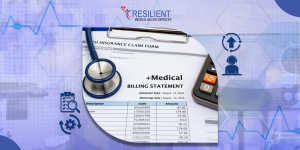A medical billing audit checklist is a powerful tool for healthcare providers, helping them assess accuracy, compliance, and efficiency in their billing practices. By identifying anomalies, reducing claim denials, and optimizing revenue cycle management, these audits are key to improving financial performance.
With a focus on HIPAA and Medicare compliance, medical billing audits not only safeguard against costly errors but also help providers streamline operations and reduce revenue losses. Ready to take your billing process to the next level? Let’s dive into the Top 10 tips for your medical billing audit checklist that can transform your financial outcomes.
1. Define the Scope of Your Medical Billing Audit
Before conducting a medical billing audit, it is essential to determine its scope. Audits might be internal or external. Healthcare providers’ billing teams perform internal audits to find problems before submitting claims. External audits are conducted by independent professionals that check billing accuracy and compliance.
A medical billing audit checklist ensures HIPAA, CMS, and insurance compliance, verifies coding accuracy to prevent undercoding or overcoding, improves revenue cycle efficiency by identifying areas for improvement, and detects billing fraud and abuse.
2. Verify Patient Information Accuracy
Incorrect patient information is a leading cause of claim denials. Ensuring the accuracy of patient demographics and insurance details is essential to prevent rejections.
Providers should verify that the name, date of birth, and address match insurance records, confirm the insurance policy number and coverage, check eligibility for services, and ensure correct spelling and formatting. By maintaining accurate patient information, healthcare providers can reduce claim denials and improve reimbursement rates.
3. Review Medical Coding Practices
Accurate medical billing and reimbursement require good coding. Use a medical coding audit checklist to assess accuracy. This medical billing audit checklist should ensure that valid codes are assigned based on documentation and meet coding standards.
Pay attention to frequent problems like upcoding (assigning a code for a higher-paying service than was supplied), undercoding (using a code that underrepresents the service), and unbundling in your audit. Early detection can eliminate costly mistakes, audit concerns, and help you comply with billing requirements.
4. Assess Claim Submission Accuracy
The next important stage is checking claim submission accuracy. Make sure claims are comprehensive, accurate, and filed on time. Verify that all relevant information is included and correctly documented to avoid payment delays or denials.
Also, look for duplicate billing and inappropriate modifier use. To ensure a smooth claims process, these errors must be addressed immediately to avoid reimbursement issues and audit red flags.
5. Ensure Compliance with Payer Guidelines
Payment criteria must be followed to avoid disputes, denials, and penalties. Keep up with Medicare, Medicaid, and private insurance requirements to ensure your practice meets all guidelines. Reviewing these rules often can help you follow payer-specific policies.
To ensure accurate service documentation and code application, review claims against payer-specific policies. Follow these suggestions to avoid audits and rejections and keep your practice compliant with industry standards.
6. Keep an eye on Patterns Of Denials and Rejections
Keeping an eye on denials and rejection trends is important for spotting common mistakes in billing and coding. By looking at denied claims, healthcare workers can identify common problems such as wrong patient information or coding errors.
Making improvements like staff training or software updates helps minimize denials and makes the claims process easier, which in turn enhances the overall management of income.
7. Evaluate Documentation and Medical Necessity
Make sure that clinical records back up the services paid and show that they are necessary for medical care. Not having enough paperwork often leads to denials, so it’s important to check that diagnoses and treatments match.
Staying informed about payer rules and making sure services are truly needed can help prevent rejections and meet healthcare regulations.
8. Review Payment Posting and Reconciliation
Correctly recording payments is important for managing cash flow. Check the payments you’ve gotten against the charges you billed to make sure that you are getting paid correctly.
Quickly resolve any mistakes and check on lost or wrong payments to keep financial records accurate and avoid payment delays.
9. Implement an Ongoing Audit Strategy for Medical Billing
An effective medical billing audit strategy is essential for financial accuracy and compliance. Consistency is key—regular audits help identify discrepancies early.
Instead of one-time reviews, schedule ongoing audits to catch mistakes, improve reimbursement rates, and prevent compliance issues. Regular audits ensure your team stays updated on coding changes, insurance requirements, and billing procedures, reducing the risk of fraud, overpayment, or claim denials.
10. Conduct Regular Training for Billing Staff
To keep up with ICD-10, CPT changes, and payer policies, the billing team needs regular training. Staff receive continual training on coding, invoicing, and insurance changes. By improving their expertise, you eliminate errors, increase claim accuracy, and ensure prompt reimbursements.
Training improves the team’s ability to spot differences, eliminating costly undercoding and overcoding. Additionally, it guarantees that the billing team follows changing regulations, protecting your clinic from audits, denials, and penalties. Implementing a medical billing audit checklist further ensures compliance and accuracy. Regular training improves billing skills and procedures.
Final Thoughts!
A properly designed medical billing audit checklist serves healthcare providers to track their financial health and prevent costly errors. Your organization can achieve accurate billing compliance and maximize reimbursement efforts by conducting audits on a regular basis.
Through proactive medical billing auditing you can identify problems in their early stages so you achieve improved operational efficiency together with early detection of errors.
If you’re looking to simplify your auditing process, outsourcing to a professional medical billing auditor is a smart move. For enhanced efficiency and peace of mind, reach out to Resilient MBS Medical Billing Audit Services today for all your medical billing audit checklist needs.










